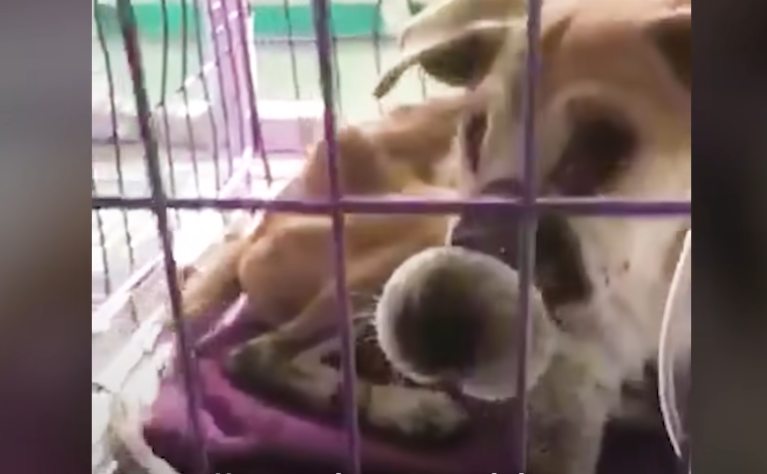The dog meat trade is an appalling and disgusting reality that tugs at the heart of every pet lover. Fortunately for one victim, lady luck intervened in time. Little Mo with her snout tied shut and limbs bound fell off one such truck and was found by rescuers in time. This was one dog whose life changed that very instant.
The shocking discovery on the road

Mo was first seen near a meat delivery vehicle, confused and hurt, with her mouth tightly taped shut. That detail alone tells you everything about the danger she faced and the panic she must have felt. A passerby realized something was very wrong and acted quickly, setting off the chain that led to her rescue. Those early minutes are everything: either someone notices and reports, or the moment is lost. In Mo’s case, someone spoke up, and that single decision changed her entire future.
Why a taped mouth is a medical emergency
Taping a dog’s mouth isn’t just cruel; it’s immediately dangerous because it blocks panting – the main way dogs cool their bodies. Without panting, heat builds up quickly and can spiral into heat stress or worse, even in ordinary weather. It also makes drinking impossible, so dehydration becomes a second, serious risk. Breathing can be compromised, pain can escalate, and panic can cause a dog to thrash and injure itself trying to escape. Every second the tape stays on, the danger grows, which is why careful removal is step one. The video underscores that urgency without drama, focusing on steady hands and clear priorities.
Mission Pawsible steps in – Prue’s team mobilizes

Mission Pawsible is the backbone of this turnaround. Prue, a recognizable face for the rescue, helps explained how the team handles high‑risk cases like Mo’s. Their approach is all action: get the dog safe, get a vet involved, and get a foster ready. Volunteers coordinate like a practiced crew, passing the baton from finder to transporter to the medical team. You can see why a strong network matters – no one person can do this alone, and every handoff is crucial. The Dodo’s coverage lifts the curtain on that teamwork, and it’s the reason Mo’s story moves so fast from crisis to care.
From triage to healing: veterinary care and daily recovery
After the tape is removed, the medical plan kicks in, starting with checking breathing, hydration, and pain. The vet looks for cuts from the fall, soft‑tissue bruising, and any signs of internal stress. Basic care comes next: wound cleaning, fluids if needed, parasite protection, and vaccinations on schedule. Pain control matters because comfort is part of healing, especially after trauma.
Recovery isn’t only clinical; it’s also about routine and safety. Mo was given a calm space, predictable feeding times, and gentle handling from people who understand fear. Each day builds on the last, from simply resting without flinching to walking outside with soft encouragement.
Trust rebuilt: Mo’s behavioral turnaround
Emotional trauma is real for dogs, and the video treats it that way, not as drama but as something you work through. The team uses positive reinforcement, short sessions, and calm voices to help Mo reset. Touch becomes a choice, not a demand, which gives her control and lowers fear. Eye contact goes from wary to curious, then to the kind of warm gaze that says, “I’m safe.” Play appears, slowly at first, as her nervous energy turns into confidence. Each step is small, but the direction is clear.
Adoption day and the dream life viewers saw
The finish line is a forever home, and Mo gets there with the kind of ease that makes you smile. Adoption turns all that careful rescue work into a daily routine that lasts. The new family builds on what Mission Pawsible started, keeping training and vet care steady. Structure stays in place, but it’s warm and lived‑in – walks, naps, meals, and the little rituals that make a dog feel rooted. The contrast with her first moments on camera couldn’t be stronger, and that’s the point. Safety isn’t a special occasion anymore; it’s her normal.
What viewers can do after watching
The story makes a bigger point: quick reporting and organized response save lives. If you see a dog in distress, document safely and contact local animal control or law enforcement right away. Support established rescues that move fast and follow through, because their logistics are the difference in emergencies. Fostering opens space for the next animal who needs out today, not tomorrow. Donations fund vet visits that turn emergencies into recoveries. Sharing credible education helps more people recognize cruelty and act quickly.
- Report suspected cruelty immediately and provide clear details if it’s safe to do so.
- Support rescue groups with donations, supplies, or volunteer time.
- Consider fostering to create breathing room for urgent intakes.
- Adopt through reputable organizations that offer post‑adoption support.
- Learn the signs of distress in dogs so you can respond faster and smarter.
Source: Original YouTube Video

Andrew Alpin from India is the Brand Manager of Doggo digest. Andrew is an experienced content specialist and social media manager with a passion for writing. His forte includes health and wellness, Travel, Animals, and Nature. A nature nomad, Andrew is obsessed with mountains and loves high-altitude trekking. He has been on several Himalayan treks in India including the Everest Base Camp in Nepal.






